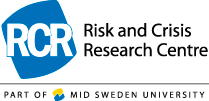Sense-making of risk: Theoretical and empirical perspectives
Dr. Erika Wall's doctoral thesis.
The thesis introduces the concept of ‘sense-making of risk’ (riskförståelse) for the purpose of the theoretical and empirical study of the individual’s sense-making of risk. Particular weight is attached to an examination of the term’s various components, its compass, and the relationship between sense-making of risk and behaviour. The premise is that risk is created and defined by the common conceptions that exist within the framework of a specific social context; the effect is to focus attention on the significance of social and cultural contexts. For this reason the thesis’s conceptual exposition draws on the likes of Karl Weick’s and Alfred Schütz’s theories of the individual’s creation of meaning.
The choice of Weick’s theory of sense-making means that the concept of sense-making of risk can be used to illustrate the individual’s personal understanding of different risks, and it is argued that the norms and values that encompass the individual, whatever the social or spatial nature of the context, are decisive for the understanding formed of a given risk. By using Schütz’s theories of social relation-ships, amongst others, the importance and function of the individual’s structure of meaning for sense-making of risk can be mapped. Structure of meaning consists of a number of different components, of which four are analysed in detail: personal experience; individual or collective orientation; place attachment; and social class. The individual, by relating the risk encountered to personal structures of meaning, creates an understanding of the specific risk. An important aspect of structure of meaning that it is socially construed by the socialization processes that operate in the individual’s specific spatial context. This means that sense-making of risk is strictly localized: the individual’s comprehension of risk depends on the social and spatial context.
To provide a full picture of sense-making of risk, and risk behaviour, and to study these phenomena using a variety of methodological perspectives, the data was gathered from both polls and focus-group interviews.
It is in the first article, based on a focus-group interview study, that the concept of sense-making of risk is introduced: the empirical results demonstrate that it can be used to chart how young people with similar risk perceptions differ in their understanding of a variety of risks. A theoretical model is proposed that establishes that there are two dimensions to the individual’s sense-making of risk. The first dimension marks the degree to which the individual’s sense-making of risk is localized; the second, whether the individual’s sense-making of risk is best described as collectively or individually oriented. Empirically, the results show that the young people in the study shared risk perceptions, but that their sense-making of risk differed, and that the differences can be attributed to their home circumstances.
The second article considers young people’s risk behaviour in traffic milieus. The study presents logistic regression analyses of data taken from the Swedish Trafiksäkerhetsundersökningen (‘Road Safety Survey’) of 2001. The principal conclusion drawn in this study is that the individual’s sense-making of risk is insufficient to explain behaviour in relation to risk: the spatial context must also be taken into account.
The third article, which is based on a focus-group interview study, applies the concept of sense-making of risk in an analysis of traffic risks. The study focuses on the relationship between place attachment and sense-making of risk, and demonstrates that various aspects of place attachment have implications for the individual’s sense-making of risk. For the young people who participated in the study, social belonging is of particular consequence for their sense-making of risk, yet the other facets of place attachment studied here also played a part.
The fourth and final article offers a cluster analysis of data from the Swedish national poll Samhälle och värderingar (‘Society and Values’) of 2008. The article’s most important result is its refinement of the theoretical concepts. Structure of meaning is singled out as the basis for the individual’s sense-making of risk. Further, an operationalization of individuals’ structure of meaning was used to group the participants. In its empirical application the concept was shown to be useful in studying the behavioural differences between various social groups, since grouping by structure of meaning furnishes an explanation for variations in risk and risk-reducing behaviour. This finding serves to illustrate the relationship between structure of meaning and behaviour in relation to risk.
The introductory and concluding chapters assemble the studies’ findings and offer a full account of the concept of sense-making of risk, detailing its special importance in describing how social and spatial contexts are integral to the individual’s sense-making of risk. The thesis’ most important conceptual contribution is to the question of how the individual arrives at a personal sense-making of risk. However, it will fall to future studies to establish the concept’s general applicability by considering its theoretical ramifications and empirical implementation. In this way, sense-making of risk can take its place in a specifically sociological conceptual apparatus that focuses on how the individual relates to risk.
Publications
Wall, E. (2010). Sense-making of risk: Theoretical and empirical perspectives. (Mid Sweden University doctoral thesis : 81)
Wall, E. (2011). Structure of meaning and sense-making of risk: An operationalisation of sense-making tested by grouping individuals according to their structure of meaning. Journal of Risk Research, vol. 14: 6, ss. 735-755.
Wall, E. (2009). Traffic safety behaviour among young people in different residential settings: The use of seat belts, bicycle helmets, and reflectors by young people in Sweden. Injury control and safety promotion, vol. 16: 4, ss. 197-204.
Wall, E. (2009). Ungdomars samtal kring risker i trafiken: relationen mellan riskförståelse och platsanknytning. Sociologisk forskning, vol. 46: 3, ss. 37-56.
Wall, E. & Olofsson, A. (2008). Young people making sense of risk: How meanings of risk are materialised within the social context of every-day life. Young - Nordic Journal of Youth Research, vol. 16: 4, ss. 431-448.

